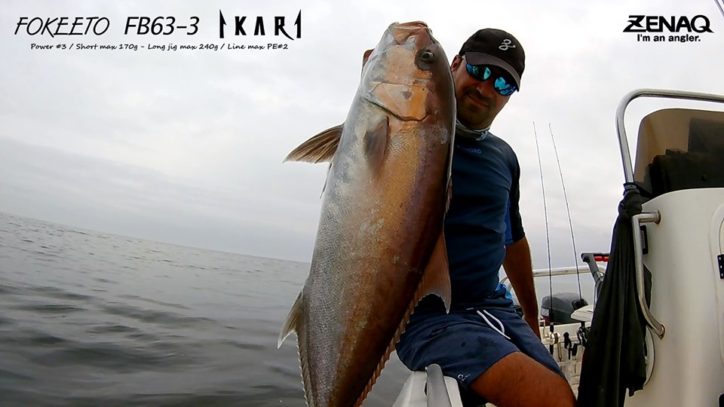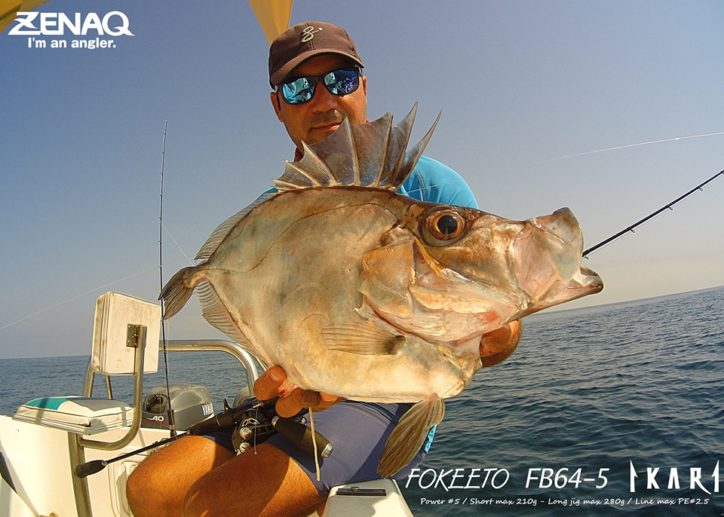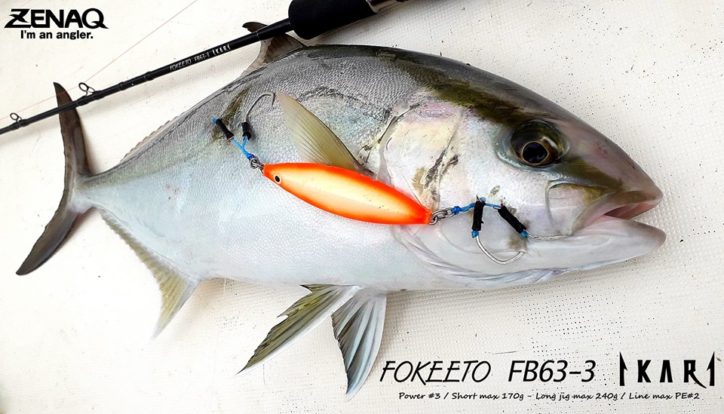Many anglers know about the fishing technique called “vertical jigging,” using which they catch predatory fish from boats. However, many subtleties (individual jigging directions) remain aloof. adriaticnature will try not to miss the nuances, and talk about all the possible fishing techniques within a separate world of “vertical jigging”.
We decided to talk about the features of Slow Pitch Jigging with the master of this fishing technique, Luis Ramos from Lisbon, Portugal, now residing in Angola, the member of the field team of the Japanese manufacturer of Zenaq spinning rods.

(Luis Ramos with a grouper caught using the SPJ technique. Foto © Luis Ramos)
– Hello, Luis! Thank you for taking the time to talk. Please tell adriaticnature readers a little about yourself.
Hi everyone. It’s a pleasure to answer any questions and help fellow SPJ fans.
My name is Luis Ramos and I live in Angola. I am a field tester for Zenaq and work as a professional fisherman, using only SPJ techniques. I’ve been blessed to be able to do this as a full-time job for the last 6 years. I also work as a jigging fishing guide occasionally.

(Greater amberjack caught using the SPJ technique. Foto © Luis Ramos)
– Vertical jigging is diverse. Tell me, please, why do you prefer SPJ when fishing for predatory fish?
I prefer the SPJ technique to the traditional SJ, because it gives me the possibility to catch any predators regardless of whether they live at the bottom or along the water column, their speed or where they feed. The concept of SPJ with its technical gear enables me to adjust the time, speed and movements of the jig according to the type of predator and its specific strike zone.
Despite the fact that the SJ technique is very effective in case of water column hunters, it’s important to be aware of the season or water temperature differences as they tend to get lethargic or slow. The same happens to bottom predators, which are slow by nature and need some time to strike. With the SPJ technique, we can control and change our set according to a specific hour, predator or season, something you cannot achieve with SJ.

(Black grouper caught using the SPJ technique. Foto © Luis Ramos)
– Is SPJ a monotonous presentation and animation of lures in water? Or are there different approaches and methods of animation?
Actually, it’s the other way around. In my opinion, the SPJ approach was a game changer in how fellow fishermen used to do speed jigging with the same old movements but still had the same problems when it came to low fish activity hours, species and different water conditions. Although the jig shapes and targets were the same, it was challenging physically because of the heavy gear, drags and high PE#.
SPJ changed everything and that took jigging to a whole new level. Now we have a lot of different jig movements and combinations, either by its natural movement or by rod and reel input. We can cover all the best movements and approaches between the different reel pitches, long fall and high pitch, no matter what the predator or situation is. From small to big, I haven’t seen a single fish that doesn’t get attracted to SPJ jigs movements.

(Cape dory caught using the SPJ technique. Foto © Luis Ramos)
– What characteristics should fishing rods and fishing reels have, if a fisherman wants to use this technique? Is it possible to fish using SPJ with the gears that are readily available in the boat?
The simple answer is yes! It is possible but the results are never the same. SPJ rods and reels are designed and meant to match perfectly the technique of this concept. Other rods lack the sensitivity, lightness, elasticity and back bone the SPJ rods have. These rods are made to give you the control you need over the jig and the awareness of what is happening underwater in order to catch fish.
The same goes for SPJ reels. It is not by chance that bait casting reels are the number one choice for SPJ fans. There are a lot of spec differences between a bait casting SPJ reel and a spinning reel that makes SPJ superior. For example, SPJ reels have more line capacity in small size reels, bottom lock or drag lever, more torque power and the possibility to pull fish without using the rod to pump it due to its mechanism. Also, the control of the pitch and the search for patterns in predators is easier. These are just some of the differences between them.
The connection between the rod and the reel I have in the palm of my hand is what stands out for me personally. I can feel all the information from my jig transmitted through the rod and line without even looking. When I get a hit when the jig is falling, I know, I can feel it. In spinning reels, you simply don’t have enough information and control to start. If we think about it, the jig is transmitting almost all of the information you need through the line and the rod stops when it reaches the roller. As I say, it all comes down to controlling your jig… if you can control your jig, you control the game.

(Zebra tilefish caught using the SPJ technique. Foto © Luis Ramos)
– There is a video on your YouTube channel where you do almost nothing with either a spinning rod or a reel. What is happening at this moment?
In this video, I was explaining a technique that I had developed and used when I got no response from predators. I do this by trying to imitate the movement of a squid using only the movement of the boat and the soft elasticity of the rod without printing any rod movement on the jig. Sometimes during this slow movement, the bait fish gets hooked on the jig and I use it as live bait; instead of removing the bait fish (one would normally do it), I use it to drive a bite from the predator.
(Greater amberjack caught using the SPJ technique. Video © Luis Ramos)
– How do you approach the issue of choosing lures? Which of them do you consider the most appropriate for SPJ today? What weights do you mainly use and at what depths?
For me, there is no such thing as all-in-one jig, because the game is always changing and we need to adapt. That is why I choose my jig considering three factors. Firstly, I test the best shape and weight of the jig according to the water conditions, knowing that everything can change at any time or depth. Secondly, I try to match the colour of the jig with the colour of the water and what the predators feed on. Finally, it is very important to try to match the movement or pattern of the jig according to the predator and the way it feeds to trigger the strike.

(Dusky kobs caught using the SPJ technique. Foto © Luis Ramos)
– What can you say about assist hooks for metal jigs? Is it worth paying attention to them, or can I use any available?
I find the shape of the assist hooks to be very important. Some predators use their mouth with teeth to bite and some use suction to swallow their prey. Some use the water column to feed and some use the bottom to lurk for prey feed. Having this predator information on how and where they feed, we can use it and adapt our assist hooks accordingly.
For example, there are some assist hooks designs that are better for hooking fish but inefficient when it comes down to bottom prison. Others are thin, light but easy to break when put under pressure. When it comes down to choosing your assist hooks, it’s a matter of using the right assist hooks for the right job. If we are looking for bottom feeders, probably the best double assist hooks will be the ones that have less probability of bottom lock but they should also be thin and light. If they feed using suction, the double assist hooks will be the first thing to get inside their mouth before the jig.
Also, it is very important to adjust the assist size of your jig to the predator. Sometimes I also use single assists in both ends instead of double assist hooks; it has to do with a specific mouth bone structure or teeth for some predators. I tend to find the right one to protect my assist cord from teeth or when I need to pass its lips and set the hook in a more solid bone area. 4 is not always better than 2 and that depends on the predator and bottom structure.

(Dogtooth grouper caught using the SPJ technique. Foto © Luis Ramos)
– Are the thicknesses of the PE braid and shock leader important in the SPJ technique? Which ones do you use in your practice?
Yes, it is very important. Sometimes you get from having no hits to hooking fish just by changing your leader or your main braid line. For me, choosing the PE# braid number or leader depends on the water conditions and terrain. I like having flexibility, so I always carry with me 3 different setups: from PE#1.5 to PE#3 braid and 30lb to 60lb fluorocarbon leader gives me the safety I need to cover any scenario.
I usually start my jigging day with PE#2.5 braid and 35Lb or 40LB fluorocarbon leader. But if I arrive at a spot in the morning or around sunset and I can spot big fish in my sonar, I change my setup to PE#3 braid line and a 50LB leader to increase my odds. If I get a hit with this setup, my chances of catching that fish rise. But if I don’t get any hits, I change back to my previous PE#2.5 and 35lb leader.
Always remember that there is no point in hooking a fish, if you know that your chances of landing it are very slim. The more prepared and conscious you are, the better your hook chances are. I believe that our decision in choosing PE# line and leader should be a balance between our fighting skills, type of predator and fishing grounds.
(Greater amberjack caught using the SPJ technique. Video © Luis Ramos)
– An angler is above the surface of the sea, the fish he is looking for wanders over the bottom or in the water column. What do you need to know and understand in order to find contact with fish using the lure and SPJ?
The most important to me is the knowledge you develop through experience on every predator that I can find in my fishing grounds, from top to bottom. I always say, never go to battle without knowing your “enemy”. Imagine, if you don’t know where it lives, feeds, the type of terrain that it likes, water temperature, whether it eats fish or seafood, or even mating season, how do you expect to catch it? If you learn all of this, then you know your “enemy”. Choosing the jig and movement becomes the easiest part. There is a big difference between catching one fish by luck and being the one who knows where to go to catch that fish.

(Greater amberjack and dusky kob caught using the SPJ technique. Foto © Luis Ramos)
– Do you use silicone lures, lures that imitate squids, octopuses and other inhabitants of the sea, inchiku and kabura, etc.? If so, what place do they occupy in your boxes and are they related to the SPJ technique?
Throughout my fishing life, I have used silicone, plastic and metal lures. From shore or in a boat, I can say I have tried them all. Of all the lures, the ones that I didn’t find very useful were inchiku, kabura or madai. In my opinion, I experienced they lacked technique and were much simpler to learn than SPJ. I love all technical challenges that make you think every second you are fishing and all the nuances that SPJ brings. We all know that these “new” techniques can catch fish, but I prefer to do my fishing with a holistic approach which is something I love and really enjoy.

(Almaco jack caught using the SPJ technique. Foto © Luis Ramos)
– SPJ means fishing from a boat. Are there any important points in equipping a boat, on which the quality of fishing will depend?
It all comes down to controlling our drift to stay vertical all the time, no matter what the sea and atmosphere conditions are during SPJ. Some fishermen use sails, all sort of anchors or engines to control the drift. For me, there is nothing like the engine on our boat for two reasons. First, no matter what the circumstances are, 90% of the time you are fishing vertically and secondly, you can use the boat to fight big runners that use the current to put more pressure on your thin line and leader. Staying vertical 90% of the time while SPJ is imperative for the success of this technique.
(Dusky grouper caught using the SPJ technique. Video © Luis Ramos)
– What set (s) of the rod + reel + cord + shock leader do you currently consider the best possible and which ones did you opt for?
For me, there is no one setup that can do it all, simply because we need different reels, rods, PE#, leaders, jig shapes and weights for different occasions and sea conditions, such as current, depth, predators or terrain. Personally, I find understanding and learning which setup to use according to each situation to be one of the most interesting parts of SPJ. This is one of the first lessons that we learn as we progress in this technique. We need to have options. Otherwise, we won’t be able to face a lot of situations. Despite that, there are some things that are “universal”, such as specific features that a SPJ reel should have or even different types of action that every SPJ rod must have.
Apart from that, choosing PE# braid or leader is something personal, because it will depend on where you fish, at what depth, the type of predators (small or big ones), and especially whether you fish at a soft or a very rocky bottom. For example, I will never use PE#1.5 braid and 30LB leader if my only purpose is to catch bottom predators like big groupers on an extremely rocky bottom. I know by experience that despite having more strikes, my chances will be very slim or almost none, when fishing lighter. Like almost everything in life, it’s a matter of balance, in this case of PE# braid and leader, between finesse, resistance and all the elements of nature.
(Fishing using the SPJ technique. Video © Luis Ramos)
– Surely you can give adriaticnature readers some advice that is not obvious, can’t you?
The best “advice” I can give my fellow SPJ anglers, especially the ones that have their own boat, is to go out and study nature and everything there is to know about what lives underwater in your area. You cannot improve your SPJ technique if you can’t find fish. So, study nature and it will show you when and where you can find the predators you are chasing. Nature is not mechanical and it will never be, but it has patterns, so it’s up to you to study and find those patterns that will help you become a better fisherman.